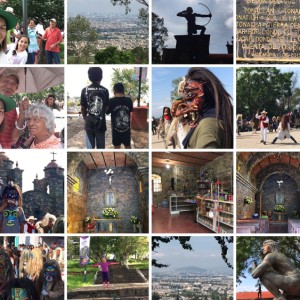Tonalá
Ahead some history about this town, full of tradition and a great place to buy artcrafts. Today we went to see a ritual the native celebrates starting today for a whole week. Tastoanes is the name of the ones wearing the masks and represent the native communities getting together to defend themselves from the Spanish...ok, here it is from Wikipedia. :-) The extras are one from this morning in Tonalá and the other this evening with my group of friends from childhood.
The name comes from the Nahuatl phrase Tonallán, which means where the sun rises.”[1][2] The town approved its seal in 1985, designed by Rogelio Contreras Colina.[2][5]
The town started as a Zapotec settlement, which latter incorporated Toltec and Nahua migrants, leaning to a blending of cultures. Another influence were the nomadic Cocos and Tecuexes, who also lived in the area. Religious practice focused on gods such as Teoplizintli (child god), Heri (sciences) and Nayart (god of war), along with Tenaguachi and Tezcatipoca.[2][5]
During the Salitre War in 1510, the Purépecha invaded the area, which at that time was a dominion, however, this effort was defeated.[2]
When the Nuño de Guzmán and Spanish arrived in 1530, the town was the capital of a dominion ruled by a woman named Cihualpilli Tzapotzinco. This dominion included Tlaquepaque, Tololotlán, Coyolán, Mexquitán, Tzalatitán, Atemajac, Tetlán, Tateposco, Tlaxomulco, Cuescomatitán, Coyutlán and Toluquilla as tribute paying entities.[2][5]
The leaders of the dominion were divided on how to respond to the foreigners Cihualpilli did not want to resist, due to Spanish power, but local leaders, notably those from Coyolan, Ichcatán, Tzalatitán, and Tetlán wanted to resist. Cihualpilli sent gifts to Guzmán, who not only demanded more, but also demanded allegiance to the Spanish king. Dissidents gathered numbering about 3,000 and attacked the Spanish. This began a battle that lasted several hours, with a Spanish victory on March 25, 1530. Cihualpilli was baptized with the name Juana Bautista. The territory was renamed Nueva Galicia and the town Santiago de Tonalá.[2][5]
The new province was initially governed by Diego Vazquez Buendia and remained the main settlement in the area until the founding of Guadalajara in 1535. Evangelization was carried out by the Franciscans and the Augustinians until the early 17th century.[2][5]
In 1824, the Tonalá became one of the twenty six departments of Jalisco, officially named a town, then in the same year became subordinate to Zapotlanejo. Through the rest of the 19th century, its status changed and was unclear, mentioned as a municipality in a decree in 1873 but declared subordinate to Zapotlanejo and San Pedro in 1889.[2][5]



Comments
Sign in or get an account to comment.


